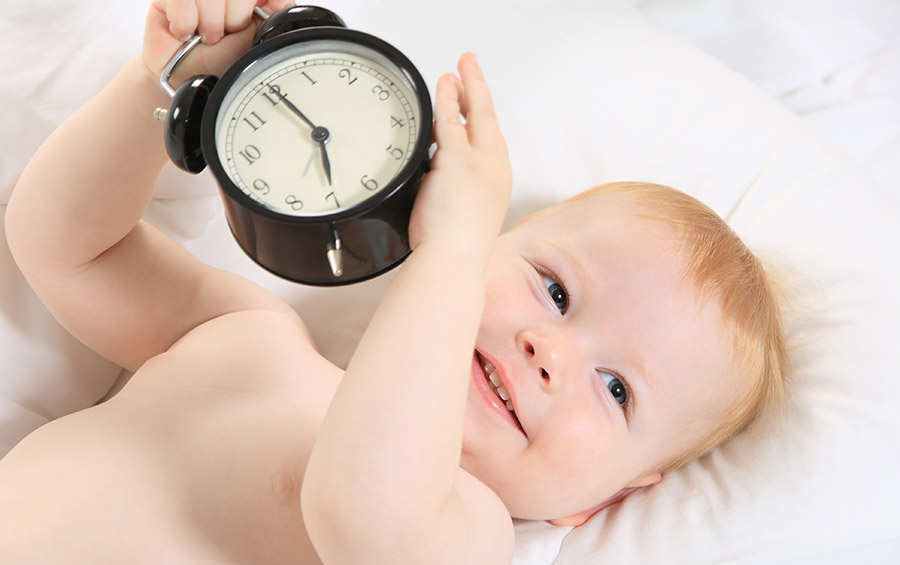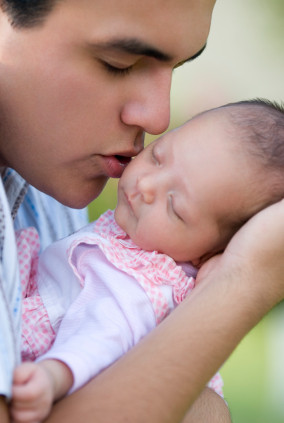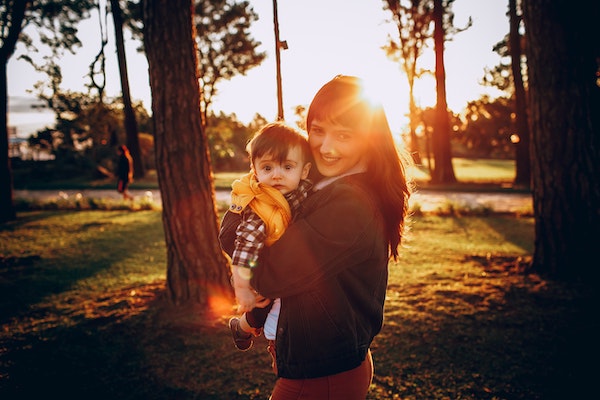3 Easy-and-Effective Tweaks To Help Your Baby Sleep When The Clocks Change (DST)
by Heidi Holvoet

To help your baby sleep when the clocks change, the classic advice is to move up your baby’s bedtime with 10 or 15-minute increments a few days before Daylight Saving Time. It can work for some, but it doesn’t work well for all babies.
Sadly this classic method often even leads to poorer rather than better baby sleep when the clocks change.
At its best, the progressive “move bedtime up” method means added stress and hassle to get it right as a parent.
Here at Baby Sleep Advice.com we have a more relaxed, and also more effective take on avoiding a sleep regression due to Daylight Saving Time.
It’s easier to do, less hassle, and more effective for most babies, newborns, older babies and toddlers alike.
And it doesn’t add extra work or stress for you at bedtime or complicated sleep schedule adjustments.
Also, the techniques are exactly the same whether the clocks spring forward or fall back.
“I used to hate it when the clocks changed”, Laurie, mom of 3, says, “It always happened right when I finally had a decent sleep schedule for my babies, and then Daylight Savings Time (DST) came and messed it all up!”
Laurie D., MA

The Super Relaxed Way to Help Your Baby Adjust to Daylight Savings Time
With our 3 tweaks below, you can safeguard your baby’s sleep schedule around a Daylight Saving Time clock change.
And you’ll find that it even supports and helps your baby to fall asleep, stay asleep, sleep through the night, and nap well also when the clocks change or recently changed.
And no, none of these 3 tweaks is that classic “start shifting your schedule 10 minutes each day a week in advance”.
Because let’s face it, that’s just hard to do – especially with ever-changing sleep patterns in young babies – and frankly it just usually doesn’t really work anyway.
Laurie’s baby girl kept sleeping marvelously when she took our different, relaxed approach last March when the clocks changed to spring forward.
(And the advice is exactly the same when the clocks change and fall back again in October/November).
“This time, as Heidi advised, I didn’t try to adjust to the time change in advance by starting to move up bedtime in advance.
I just focused on our usual sleep schedule and was extra careful with the ‘baby sleep essentials’ from Heidi’s programs: the bedtime routine and calming activities we had around bedtimes.
My 5 month old baby girl had just gotten over a cold so I made sure to help her catch up on as much sleep as possible – we even cheated a bit here with extra walks in the stroller to get at least one super long nap.”
Laurie D., MA

That extra diligence Laurie applied in the week before the clocks changed, made sure the whole family was as rested as could be and that’s really key.
And it’s not about sleeping 12 uninterrupted hours a night and taking textbook 2-hour naps for the little ones.
Few babies sleep that perfectly, even with due diligence.
It’s only about getting all the sleep you can get, and relaxing about everything else.
“And then when the night of the time change came,” Laurie continues, “I did Heidi’s ‘3 simple tweaks’ and for the first time in years this was a non-event!
Not just for the baby, but also for my 2-year old toddler and my 5 year old son. They all slept beautifully before and after, we could’ve easily forgotten about DST this time around!”
Laurie D.. MA
Have a read of the 3 tweaks and see if they feel right to optimize how you and your baby sleep when the clocks change:
DST Tweak #1. Switch to the new time “flexi-turkey”
Definition of flexi-turkey: combining a cold-turkey switch with being flexible. Here’s how it goes.
The night before the clocks change, set your manual watches and clocks if you have any to the new time. Of course, let your electronic devices adjust automatically during the night.
Then, forget about the whole thing.
Really, don’t give it a-ny thought.
This means: live by the new time. Don’t think back and don’t calculate back. If you catch yourself thinking “it would be 1pm now if it were yesterday”, stop.
Sleep and everything related to it – like helping your baby settle, fall asleep, sleep through the night and nap well – is very much linked to what happens in your mind.
That’s why consciously and decisively making the DST time switch in your mind, is key.
It’s simple sleep science and truly helps not only newborns, older babies and toddlers but also older children and adults adjust more comfortably.
Heidi Holvoet, baby sleep consultant
How to be flexible and consistent at the same time
From the morning of the time change onwards, in your baby’s sleep schedule, naps and nights start at their usual times.

For your baby’s body of course this means starting sleep an hour earlier (spring forward) or later (fall back) than usual.
The only thing to keep in mind then is to be a little flexible and especially with young babies to be extra mindful of their sleepy signs.
This can mean starting a nap or the night slightly sooner or later.
But only base this on how they feel and behave. Otherwise for everything time-specific, just use your (adjusted) clocks.
By doing this, you’re offering a fundamentally strong schedule right off the bat and offer just enough flexibility to make it a smooth transition.
Most families find that within 2-3 days their sleep schedules are back to normal with no or very little sleep disturbance and above all very little stress for all the family.
In fact, like Laurie, many parents report that sleep and their baby’s sleep schedule and sleep overall somehow improves soon after the clocks changed. This is often simply thanks to that extra diligence with the basic sleep hygiene AND the relaxed approach.
What about morning wake-ups?
Also here, no need to plan for any changes.
If your own morning routine allows it, let your baby sleep in if they like, or wake a bit earlier if that happens.
Then go about your day as normal, living by the new time.
DST Tweak #2. Use light cues
Our sleep is governed by our circadian rhythm, our daily biological clock.
That rhythm determines, also for babies, when they’re most able to settle, fall asleep and stay asleep.
When challenged by a time change, this rhythm gets a bit jumbled. That’s why your baby needs all the help they can get to let their rhythm re-settle quickly. Light cues are the best helpers here.
“Light is the most reliable and thus the primary zeitgeber”, writes sleep scientist Matthew Walker in his book Why We Sleep.
This means that light has the power to help manage your baby’s daily body clock. It does this by helping regulate melatonin, the sleep hormone.
That’s why you can, and should, use light cues to help adjust to the new time even more quickly.
Matthew Walker, sleep scientist
How to apply light cues to help your baby sleep when the clocks change
Bright mornings
As soon as your baby wakes in the morning, have bright light all around.
This is daylight if possible, but artificial light if you haven’t got much natural light available.
So open the curtains, switch on your brightest lights, go outside for a bright morning walk and a sunny early afternoon walk, and so on.

Photo by Helena Lopes
Whatever you need to do to expose your baby to nice bright light. For naps, dim lights are fine so you can simply do lights as you usually did for naps before this Daylight Savings Time change.
Dim evenings
Then from early evening onwards, start dimming the light.
From 1-2 hours before your baby’s actual bedtime routine, have dim and limited light only.
Avoid blue light as much as you can because the blue wavelengths in bright white light are hampering melatonin production.
You can avoid a lot of blue light by using red or amber-colored lamps and night lights for your baby.
Also think of the electronic devices your baby may be exposed to before bed, whether that’s an iPad or a phone, or a computer. Ideally, avoid all screen time in the 2 hours before bed.
If you can’t avoid screen exposure altogether, use the nightshift function that most devices now have to block out the blues in the light emitted by the screens.
Remember, light is the most powerful external factor in facilitating sleep for your baby.
It may feel trivial to switch on that extra lamp in the morning. It may feel silly to have that extra outdoor time in the early afternoon and then spend some time in the near dark at night.
But truly, light cues are the single most helpful way to adjust sleep patterns. So don’t ignore them, especially now that the clocks change.

DST Tweak #3. Use activity cues
Last but not least: activity cues can also help your baby tune in to the new rhythm faster.
Of course that includes your usual activities and bedtime routine. Also think of using what you do to make a clear difference between awake time and (almost) sleep time.
Active mornings
As soon as the day starts, act clearly awake and active (you may need your morning coffee first!).
Use happy upbeat voices, play silly games, have some fun music on, etc.

Also go out for walks, go play at the park, visit a friend or go to a baby playgroup, and so on. Then quiet down a bit again towards nap time. And then start a brand new active stretch after the nap.
Chillax evenings
Then in the 1-2 hours before bed, slowly quiet down.
Use soft quiet voices, read a book instead of playing an exciting game and have some quite, relaxing “spa” music on. That’ll help your baby wind down and gently get ready for sleep. All set to go down for a peaceful night.
That’s it, let the clocks change, we’re cool!
The 3 tweaks we just talked about to help your baby sleep when the clocks change are backed by science, and our experience with 1000s of families worldwide.
Have a try with them this week when Daylight Savings Time comes around and see how they work for you and your baby.

Baby waking every hour?
by Heidi Holvoet, PhD

A Bedtime Routine: Settling To Sleep Like A Charm
by Heidi Holvoet, PhD

Separation Anxiety
by Heidi Holvoet, PhD

Colic
by Heidi Holvoet, PhD

Why does my baby wake up every hour?
by Heidi Holvoet, PhD




